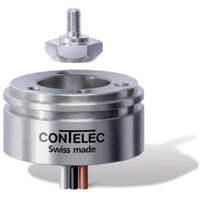
Posted to News on 28th Mar 2010, 00:00
Non-contact sensors open up applications
In applications where conventional angle sensors prove unsuitable, non-contact rotary sensors with offset magnetic transducers represent a virtually perfect alternative.

Reliable linkage of an angle sensor to the self-rotating element is, one would have thought, an established and unproblematic issue. That is not always the case. High-resolution, precision rotary sensors tolerate no torsion of the linkage, with any twist of the axis generating erroneous angle data. Despite this, it is still common to see so-called "over-engineered designs" in which there is rigid linkage between the sensor axis and the rotating element. This can lead to a number of problems, including increased mechanical wear of the sensor bearings, resulting from transverse forces, and even possible fracturing of the sensor axis.
A remedy is offered by state-of-the-art non-contact magnetic angle sensors, in which there is no direct contact between the rotating magnet and the actual measurement system. As a consequence, there are no axially or radially acting forces, which could cause increased wear and adversely affect the life of the sensor. The working distance between the magnet and measurement system and the permissible installation tolerance in Z can be optimised by choosing a suitable magnet. Depending on the size of the magnet, a range of axial offset distances is possible in the XY direction, while maintaining constant linearity.
Non-contact rotary sensors are not only free of wear and extremely robust in withstanding external influences, but demonstrate impressive long life, precision and resolution. They are available both as standard components and as bespoke designs and, depending on the version, have tolerances of several millimetres in terms of axial offsets. They also boast impressive performance features, such as maximum 14-bit resolution and 10-bit precision at a linearity of 0.3%. And non-contact rotary sensors are not just suitable for applications with axial offsets (XYZ tolerances). They are also ideal for other tasks that are very difficult - or even completely impossible - to implement with conventional rotary sensors. These include transmissive measurements, in which it is necessary to measure the angle through liquid or solid materials.
Minimum torque requirements
A further area can be found in applications in which minimum torque is essential - for example in devices for measuring wind direction. Hitherto, solutions of this kind have required extremely expensive sensors and bearing systems to achieve torque levels as low as 0.002 to 0.003Ncm. This is an application that is virtually made for non-contact sensors, since the mechanical separation of the sensor and permanent magnet ensures that there is no torque, and consequently no friction. The new sensors even allow affordable implementation of redundant systems without essentially increasing torque.
With existing rotary sensors with jewel bearings, it has not been possible to improve on torque levels of 0.004 to 0.006Ncm. Another deficiency of conventional low-torque systems is their inadequate seal tightness for a large number of applications. In many cases, the maximum seal tightness class is IP60, since at any higher values, the O-ring would effect an excessive increase in the torque. Non-contact rotary sensors, by contrast, allow the production of extremely seal-tight sensors, because the only part of the sensor that needs sealing is the one on which there are no moving components.
In applications requiring a low torque level of the angle sensor, the earth's magnetic field comes into play. This acts on the permanent magnet, trying to align this in parallel with the north-south magnetic poles, and by doing so imposes a torque on the magnet. However, in the case of small permanent magnets with simple dipole magnetisation, this torque is in the order of magnitude of 0.0002Ncm and, as a consequence, is generally non-critical. Motors, live coils or permanent magnets positioned nearby can interfere with sensors working on the magnetic measurement principle. It is therefore important to screen the sensors from magnetic interference fields. The screening is performed by surrounding the magnet and sensor with a material that conducts magnetic flux. To ensure that the performance of the sensor is not impaired, this material has to have special properties. The use of a simple magnetic steel sheet is frequently insufficient for this purpose.
Some benefits that make non-contact and contactless rotary sensors so valuable are shared by optical encoders. However, in the latter case, these advantages are frequently eliminated by major disadvantages, such as size, price, possible fogging and breakage of the code disk. By contrast, the latest generation angle sensors achieve specifications that would be inconceivable with optical systems. These include miniature sensors with weight-optimised magnets and magnet carriers with impressively low external diameters of just 13mm, resolutions of up to 14-bit and precision of up to 10-bit.
Solutions are also available that are particularly suited to heavy-duty applications, which are unsusceptible to intense vibrations and impacts. A key feature here is that, in addition to standard products, custom solutions with individualised performance features and designs are obtainable. They differ in aspects such as body shape, magnetic transducer, distance between the permanent magnet and the measurement system and permitted tolerances. Solutions with body diameters from 13mm to 37mm, resolutions of up to 14-bit, IP69K-specified versions and versions for the temperature range between -40ºC and +125ºC are available as both standard components and custom designs.









